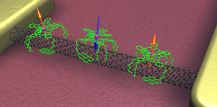Molecular spin-valve devices
-
Stellenart:
PhD/Postdoc
- Kontaktperson:
A molecular spin-valve (MSV) (Fig.1) is a gated three-terminal device, where the current passes through a non-magnetic quantum conductor (quantum wire, nanotube, molecule, or QD). The magnetic molecule is only weakly coupled to the non-magnetic conductor but its spin can influence the transport properties. Its specificity is that conduction does not occur through the SMM.
Recently, we have built a novel spin-valve device in which a non-magnetic molecular quantum dot, consisting of a Single-Wall Carbon Nanotube contacted with non-magnetic electrodes, is laterally coupled via supramolecular interactions to a TbPc2 molecular magnet. The localized magnetic moment of the SMM leads to a magnetic field-dependent modulation of the conductance in the nanotube with magnetoresistance ratios of up to 300% below 1 K. Our results open up prospects for new spintronic devices with quantum properties.
The weak coupling between the SMM and the quantum conductor ensures the preservation of the intrinsic properties of the SMM. Because coupling is small, MSVs permit readout of the spin state with minimal back-action.
 Fig. 1: A spin valve built entirely from soft organic materials rather than the usual inorganics: A lead made of a Single-Wall Carbon Nanotube (black in the Figure) is contacted at each end by non-magnetic electrodes (gold colour). It is coupled laterally to molecular, TbPc2 (Pc = phthalocyanine) quantum magnets (green), the latter acting as localized magnetic moments. Sweeping a magnetic field modulates the conductance through the nanotube, achieving magnetoresistance ratios up to 300% between fully polarized and non-polarized molecular configurations.
Fig. 1: A spin valve built entirely from soft organic materials rather than the usual inorganics: A lead made of a Single-Wall Carbon Nanotube (black in the Figure) is contacted at each end by non-magnetic electrodes (gold colour). It is coupled laterally to molecular, TbPc2 (Pc = phthalocyanine) quantum magnets (green), the latter acting as localized magnetic moments. Sweeping a magnetic field modulates the conductance through the nanotube, achieving magnetoresistance ratios up to 300% between fully polarized and non-polarized molecular configurations.

Several mechanisms can be exploited to tune the coupling between SMMs. We will focus on CNT devices, as shown in Fig. 2, where several local gates allow us to apply very locally the electric field. Preliminary studies showed that this method is able to switch on and off the coupling between the CNT and the SMMs deposited onto the nanotube. We can thus think about nanotube mediated coupling and decoupling of two SMMs.
References:
Urdampilleta, M., Klyatskaya, S., Cleuziou, J.-P., Ruben, M. and Wernsdorfer, W.,
Supramolecular spin valves,
Nat. Mater. 10, 502–506 (2011).
Urdampilleta, M., Klyatskaya, S., Ruben, M. & Wernsdorfer, W.,
Landau-Zener tunneling of a single Tb3+ magnetic moment allowing the electronic read-out of a nuclear spin,
Phys. Rev. B 87, 195412 (2013).
Urdampilleta, M., Klyatskaya, S., Ruben, M. and Wernsdorfer, W.,
Magnetic Interaction Between a Radical Spin and a Single-Molecule Magnet in a Molecular Spin-Valve,
ACS Nano 9, 4458–4464 (2015).

